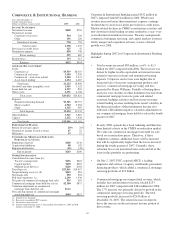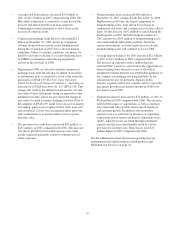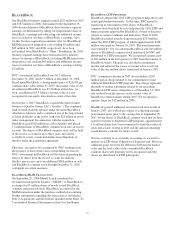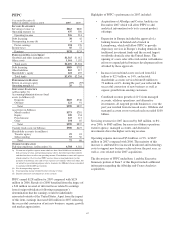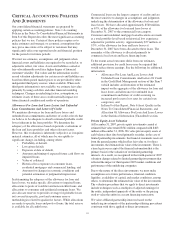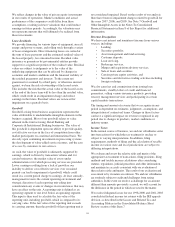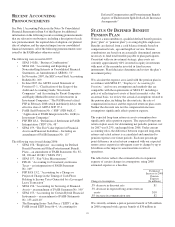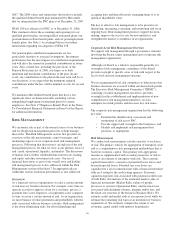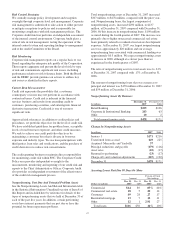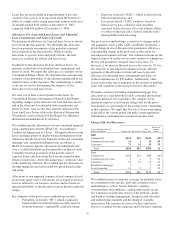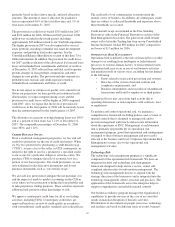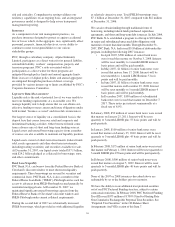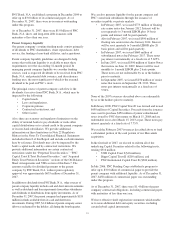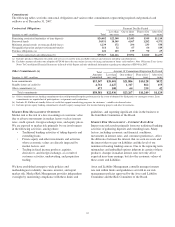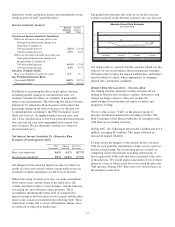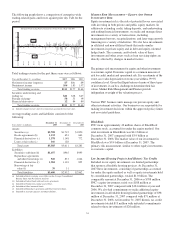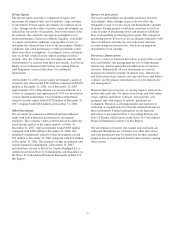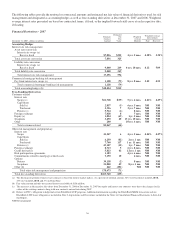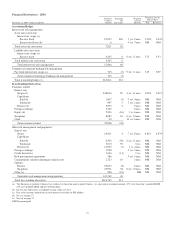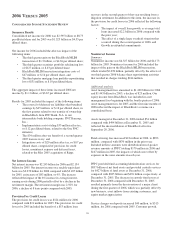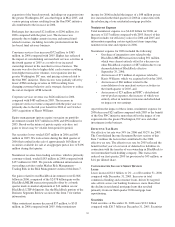PNC Bank 2007 Annual Report Download - page 54
Download and view the complete annual report
Please find page 54 of the 2007 PNC Bank annual report below. You can navigate through the pages in the report by either clicking on the pages listed below, or by using the keyword search tool below to find specific information within the annual report.primarily based on the relative specific and pool allocation
amounts. The amount of reserve allocated for qualitative
factors represented 4.6% of the total allowance and .1% of
total loans at December 31, 2007.
The provision for credit losses totaled $315 million for 2007
and $124 million for 2006. Of the total 2007 provision, $188
million was recorded in the fourth quarter, including
approximately $45 million related to our Yardville acquisition.
The higher provision in 2007 was also impacted by our real
estate portfolio, including residential real estate development
exposure, and growth in total credit exposure. See the
Consolidated Balance Sheet Review section of this Item 7 for
further information. In addition, the provision for credit losses
for 2007 and the evaluation of the allowances for loan and lease
losses and unfunded loan commitments and letters of credit as
of December 31, 2007 reflected loan and total credit exposure
growth, changes in loan portfolio composition, and other
changes in asset quality. The provision includes amounts for
probable losses on loans and credit exposure related to
unfunded loan commitments and letters of credit.
We do not expect to sustain asset quality at its current level.
Given our projections for loan growth and continued credit
deterioration, we expect nonperforming assets and the
provision for credit losses will be higher in 2008 compared
with 2007. Also, we expect that the level of provision for
credit losses in the first quarter of 2008 will be modestly lower
than the amount reported for the fourth quarter of 2007.
The allowance as a percent of nonperforming loans was 190%
and as a percent of total loans was 1.21% at December 31,
2007. The comparable percentages at December 31, 2006
were 381% and 1.12%.
C
REDIT
D
EFAULT
S
WAPS
From a credit risk management perspective, we buy and sell
credit loss protection via the use of credit derivatives. When
we buy loss protection by purchasing a credit default swap
(“CDS”), we pay a fee to the seller, or CDS counterparty, in
return for the right to receive a payment if a specified credit
event occurs for a particular obligor or reference entity. We
purchase CDSs to mitigate the risk of economic loss on a
portion of our loan exposures. For credit protection, we use
only traditional credit derivative instruments and do not
purchase instruments such as “total return swaps.”
We also sell loss protection to mitigate the net premium cost
and the impact of mark-to-market accounting on the CDS in
cases where we buy protection to hedge the loan portfolio and
to take proprietary trading positions. These activities represent
additional risk positions rather than hedges of risk.
We approve counterparty credit lines for all of our trading
activities, including CDSs. Counterparty credit lines are
approved based on a review of credit quality in accordance
with our traditional credit quality standards and credit policies.
The credit risk of our counterparties is monitored in the
normal course of business. In addition, all counterparty credit
lines are subject to collateral thresholds and exposures above
these thresholds are secured.
Credit default swaps are included in the Free-Standing
Derivatives table in the Financial Derivatives section of this
Risk Management discussion. Net gains from credit default
swaps, reflected in the Trading line item on our Consolidated
Income Statement, totaled $38 million for 2007 compared to
net losses of $17 million for 2006.
O
PERATIONAL
R
ISK
M
ANAGEMENT
Operational risk is defined as the risk of financial loss or other
damage to us resulting from inadequate or failed internal
processes or systems, human factors, or from external events.
Operational risk may occur in any of our business activities
and manifests itself in various ways, including but not limited
to the following:
• Errors related to transaction processing and systems,
• Breaches of the system of internal controls and
compliance requirements, and
• Business interruptions and execution of unauthorized
transactions and fraud by employees or third parties.
Operational losses may arise from legal actions due to
operating deficiencies or noncompliance with contracts, laws
or regulations.
To monitor and control operational risk, we maintain a
comprehensive framework including policies and a system of
internal controls that is designed to manage risk and to
provide management with timely and accurate information
about the operations of PNC. Management at each business
unit is primarily responsible for its operational risk
management program, given that operational risk management
is integral to direct business management and most easily
effected at the business unit level. Corporate Operational Risk
Management oversees day-to-day operational risk
management activities.
Technology Risk
The technology risk management program is a significant
component of the operational risk framework. We have an
integrated security and technology risk management
framework designed to help ensure a secure, sound, and
compliant infrastructure for information management. The
technology risk management process is aligned with the
strategic direction of the businesses and is integrated into the
technology management culture, structure and practices. The
application of this framework across the enterprise helps to
support comprehensive and reliable internal controls.
Our business resiliency program manages the organization’s
capabilities to provide services in the case of an event that
results in material disruption of business activities.
Prioritization of investments in people, processes, technology
and facilities are based on different types of events, business
49


